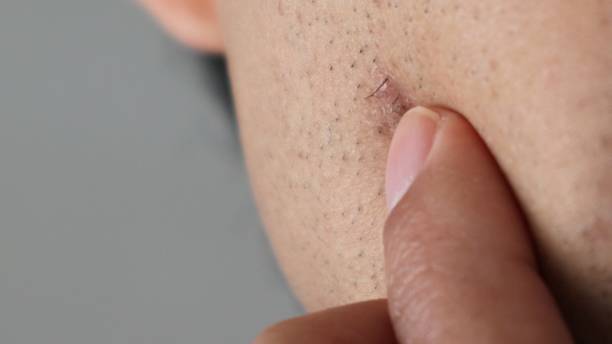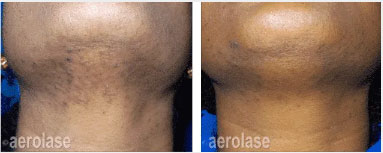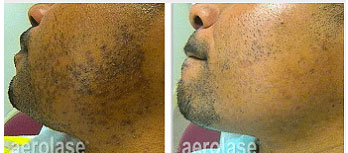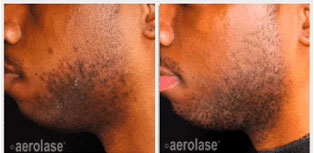
Table of Contents
How to Get Rid of Razor Bumps
Definition of Razor Bumps
Razor bumps, or pseudofolliculitis barbae, are a common skin condition characterized by small, irritated bumps on the skin after shaving. These bumps arise when hair re-enters the skin or grows sideways, leading to inflammation.
What Causes Razor Bumps?
The primary cause of razor bumps is the shaving process, particularly in areas with coarse or curly hair, like the beard area. Factors such as the type of razor used, shaving technique, and the direction of hair growth play significant roles.
Understanding the Connection Between Shaving and Razor Bumps
The Role of Hair Type in Razor Bumps
Individuals with curly hair, especially Black people and those of African or European descent with coarser facial hair, are at a higher risk. The irregular shape of curly hair shafts can easily lead to ingrown hairs.
The Impact of Shaving Techniques on Razor Bumps
Improper shaving techniques, such as shaving against the direction of hair growth, using old razors, or applying too much pressure, can exacerbate razor bumps. Achieving a close shave without causing skin irritation requires proper technique and care.
Book Your Free Consultation Today Or Call (647) 560-9233
By providing your phone number you agree to receive informational text messages from laserskin.ca. Consent is not a condition of purchase. Message frequency will vary. Msg & data rates may apply. Reply HELP for help or STOP to cancel.
How to Get Rid of Razor Bumps with Aerolase Laser



Aerolase Laser for Razor Bumps Laser therapy represents a more advanced treatment option for razor bumps. The Aerolase laser, for instance, targets the hair follicles, reducing the inflammation and occurrence of ingrown hairs. It’s particularly effective for individuals with darker skin types, as it is designed to prevent the discoloration that can accompany laser treatments. Several sessions may be required, and it’s important to consult a dermatologist with experience with laser hair removal to ensure safety and effectiveness.
The Science Behind Razor Bumps
Hair Growth and Razor Bumps
Ingrown hairs occur when shaved hairs grow back into the skin, leading to inflammation and sometimes infection. This condition is particularly prevalent in the beard area but can affect any body part with hair.
Skin Irritation and Inflammation
Shaving may strip away the upper layer of skin, which is irritating. As the hair grows back, it might not emerge in alignment with the skin’s surface, which can cause discomfort and result in itchy, painful bumps.
The affected areas can become red and inflamed and may even develop scars in severe cases.
Common Symptoms of Razor Bumps
Identifying Razor Bumps
Razor bumps are small, raised lesions that can be red, itchy, and uncomfortable. They typically appear in the shaved area, such as the face, neck, or pubic area.
When to Seek Medical Help
In cases where razor bumps lead to severe skin irritation, infection, or scarring, it’s advisable to seek medical help. A skin specialist can offer a diagnosis and suggest treatment possibilities, such as prescribed medications or laser therapy.
Steps to Prevent Razor Bumps
Preparing Your Skin for Shaving
Start with a clean washcloth and warm water to open the pores and soften the hair. A mild cleanser can help remove dirt and oil, reducing the risk of irritation.
Best Shaving Practices to Prevent Razor Bumps
Use a sharp, clean razor blade and shave toward hair growth. Short strokes with minimal pressure can help minimize skin irritation. Using a hydrating shaving cream or gel can also safeguard the skin.
Post-Shaving Care to Minimize Razor Bumps
Applying a cold compress can offer instant soothing to the skin after shaving. Moisturizing creams, especially those containing aloe vera or tea tree oil, aid in the healing process and help prevent the formation of new shaving bumps. Natural solutions like apple cider vinegar or witch hazel also reduce swelling and calm irritated skin.
Other Treatment Options for Razor Bumps
Over-the-Counter Treatments
When managing razor bumps, over-the-counter (OTC) options are a good first step. Salicylic or glycolic acid products can help by exfoliating dead skin cells and freeing trapped hairs. Benzoyl Peroxide is another popular choice; known for its effectiveness in treating acne, it can also reduce the inflammation associated with razor bumps. These products can be found in various forms, such as creams, gels, and pads. It’s recommended to follow the label’s instructions and use them consistently for the best results.
Natural Home Remedies
Natural home remedies are often touted for their amazing uses in skin care, and this extends to the treatment of razor bumps. Aloe vera, directly from the plant, can soothe irritated skin and may help heal. Similarly, applying cold compresses soaked in cold water can reduce inflammation in the affected area.
Tea tree oil, recognized for its germicidal qualities, can be mixed with a base such as olive oil and dabbed onto the bumps using a cotton ball.
In cases where razor bumps are more severe, a medical professional might recommend prescription drugs for treatment. Topical antibiotics or retinoids can reduce inflammation and prevent new bumps. Sometimes, if the condition is persistent or causes significant discomfort, a doctor may prescribe a short course of oral antibiotics. I’d like to point out that discussing your medical history with your provider is essential to determine the best action.
Common Misconceptions About Razor Bumps
Many believe that shaving more frequently will reduce razor bumps, but this is not always the case.
Shaving regularly can provoke irritation of the skin and intensify the problem. Another common myth is that only coarse facial hair causes razor bumps. While it’s true that people with curly or coarse hair may experience razor bumps more frequently due to the hair’s tendency to curl back into the skin, anyone can develop them regardless of hair type.
Tips for Avoiding Common Mistakes
The American Academy of Dermatology suggests that shaving in the direction of hair growth and using a single-blade razor can help minimize the risk of razor bumps. It’s also important to avoid pulling the skin taut while shaving and to use moisturizing shaving cream to reduce friction. Remember, the best practices for shaving include using gentle pressure, rinsing the blade after each stroke, and changing blades regularly.
Razor Bumps and Related Skin Conditions
The Link Between Razor Bumps and Keratosis Pilaris Razor bumps and keratosis pilaris manifest as small bumps on the skin but have different causes. Keratosis pilaris occurs when keratin builds up and blocks hair follicles, while ingrown hairs typically cause razor bumps.
Razor Bumps vs. Acne
Differences and Similarities Razor bumps and acne can appear similar, but razor bumps are specifically the result of hair removal. In contrast, acne is caused by oil build-up and dead skin cells blocking pores. Both conditions can cause redness and inflammation; in some cases, topical treatments like benzoyl peroxide can benefit both.
Q&A
- What is the best way to prevent razor bumps on sensitive skin?
The best way to prevent razor bumps on sensitive skin is through proper shaving techniques and skin care.
Utilize a sharp, single-blade razor, shave along the hair growth direction, and refrain from repeatedly shaving over the same spot. Placing a warm compress on the skin before shaving can soften the hair and skin, facilitating a smoother shave with less irritation. After shaving, a moisturizer enriched with natural oils and Vitamin E can soothe the skin and reduce the risk of razor bumps.
- Can chemical depilatories be used for hair removal on the face, and are they safe?
Chemical depilatories can be used for hair removal on the face, but caution is advised, especially for those with sensitive skin or a darker skin colour. These products break down the hair shaft, allowing easy removal without a razor.
Adhering to the guidelines closely, performing a patch test to detect any negative reactions, and selecting products specifically formulated for facial application are crucial steps.
- Can natural remedies be created at home for razor burns?
Indeed, various homemade natural remedies can effectively treat razor burns.
A highly suggested method involves directly applying aloe vera gel from the plant to the troubled skin area for soothing relief and to assist in the healing process. Alternatively, mixing a few drops of tea tree oil with a base oil and applying this mixture can also help alleviate skin irritation. Anecdotal evidence also supports using cold compresses to reduce redness and inflammation.
- How can I achieve a closer shave without exacerbating shave bumps?
To achieve a closer shave while minimizing the risk of shave bumps, it’s important to exfoliate the skin beforehand to remove dead skin cells. Shave after a warm shower when the hair is softer, and use a shaving cream to reduce friction. Shave with the grain in short strokes and avoid stretching the skin. Always use a clean and sharp razor, and consider using an electric razor at a slight angle to the skin’s surface for a safer, closer shave.
- Is it true that daily shaving can permanently change how body hair grows?
No, shaving every day does not permanently change how body hair grows. The genetic tendency of your hair growth, including the angle of the follicle and the hair shaft, remains unchanged by shaving. However, frequent shaving can cause temporary irritation and increase the risk of ingrown hairs, especially if done against the grain or with improper technique.
Conclusion: How to get rid of razor bumps
To ensure a smooth, bump-free shaving experience, it’s vital to establish a shaving regimen that encompasses thorough skin preparation, selecting the appropriate instruments, and diligent post-shaving maintenance. Implementing correct shaving methods, hydrating the skin, and utilizing suitable skincare products are pivotal in maintaining a sleek and bump-free complexion.
The regime following your shave is as pivotal as the shave itself. Employing a hydrating lotion can restore the skin’s natural moisture and facilitate recovery. Periodic skin exfoliation is also recommended to impede the build-up of dead skin cells, ensuring your skin remains pristine and less susceptible to the formation of razor bumps. Embracing preventive skincare practices and adhering to a regular skincare routine are the most effective tactics to keep your skin healthy and devoid of razor bumps.
In addition to these measures, those seeking advanced treatment options can consider Aerolase laser therapy, which is available at Laser Skin Clinic locations in Toronto and Richmond Hill. This state-of-the-art treatment targets hair follicles to minimize inflammation and reduce the occurrence of ingrown hairs, offering a cutting-edge solution for persistent razor bumps.
